Do you have a cat that sometimes develops acne on its chin? If so, you’re not alone. Cat acne is a relatively common problem, and there are ways to treat it effectively. In this blog post, we’ll discuss the causes of cat acne, how to treat it, and how to prevent it from happening in the future.
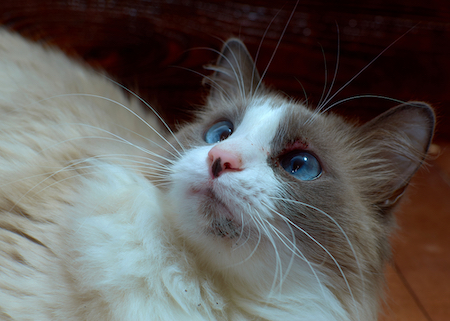
What is cat acne?
Like people, cats can get acne, too. Cat acne usually occurs on the face and throat, where the hair follicles around sebaceous glands become clogged and blocked. The oil-producing cells are next to these blockages, which causes an outbreak of blackheads or whiteheads.
An affected cat typically develops pimples under their jawline and on their chin. The spots and associated inflammation can extend to other mouth parts, including the lips and muzzle. Occasionally, the pimples may appear on different parts of the feline body. The result is a painful and uncomfortable experience for your kitty.
Are certain cats prone to cat acne?
Veterinarians believe that cats of any age can develop acne. Still, it tends to be most prominent amongst middle aged cats. This research may not sound too concerning at first. Unfortunately, an acne outbreak can lead to serious health issues for breeds like Persians and Himalayan Cats. They have an increased risk of idiopathic facial dermatitis or primary seborrhea, both extreme skin conditions.
Cat acne is arguably both a common and uncommon medical condition. More research is necessary to determine how common it is. It may be challenging to establish if cats have mild cases that clear up independently. Often, pet parents don’t take their cat to the vet for such a seemingly small matter. Also, some cats develop it once and never again; for others, cat acne occurs frequently.
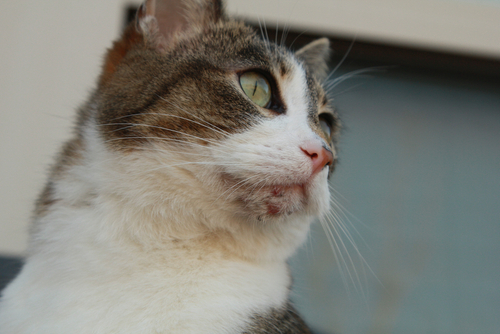
What causes cat acne?
There are many potential causes of cat acne. This condition can occur due to a high level of keratinization, a protein found in the outer skin layer. Comedones (blackheads), which are caused by excess keratin in the hair follicle, can form. If bacteria are present in the comedones, pimples develop. Folliculitis, an inflammation of the hair follicles, and ts, larger blisters that look like boils, are two of the most common symptoms of cat acne.
However, there are other causes for this particular medical issue, including:
Allergies: A cat with allergies is more likely to get acne. Itchy skin and scratching cause the release of hormones that stimulate oil production. Bacteria growth in pores occurs, leading to blocked follicles and pimple formation.
In particular, studies have shown that some cats develop acne from coming into contact with plastic food and water bowls. Plastic materials are easily scratched, allowing bacteria to grow inside those areas. Each time a cat’s mouth or chin comes into contact with the contaminated plastic bowls is a chance for an acne flare-up.
Other causes of cat acne include:
- stress
- hormone imbalances
- poor grooming habits
- sensitivity to chemicals or foods
- exposure to bacterial overload, especially on dirty food dishes and bowls
- flea bites
- mite infestation
- genetics
- viral infections (especially respiratory)
- immunosuppression
A veterinary examination is recommended regardless of the cause of your cat’s acne. Cats with acne lesions and weeping sores should see a vet as soon as possible.
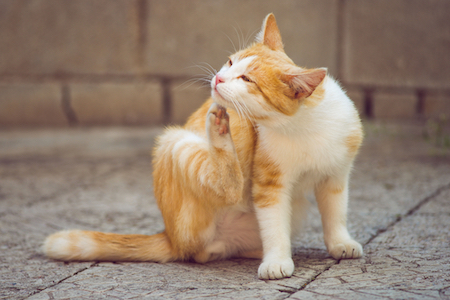
What are the symptoms of cat acne?
The appearance of a dirty chin is the most common indication of cat acne. Lesions may appear on this area and other nearby mouth parts, like the upper and lower lip.
An examination of your cat’s skin may show blackheads and infected follicles. There may be scabs, dark black crusts, red pimples and bumps, or small white spots. Some cats may even experience a combination of these symptoms.
There may also be swelling in the lips or chin, accompanied by inflamed tissue. The skin on a cat’s chin can become thick and scaly, often caused by them rubbing or scratching their chin against furniture to ease the itchiness and pain.
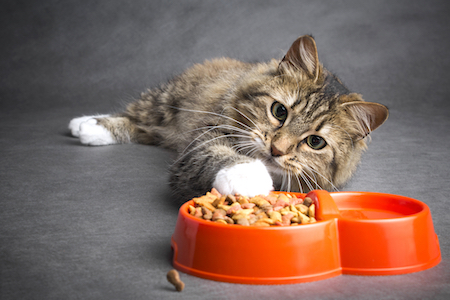
What treatments are available for cat acne?
The severity of your cat’s acne will determine what treatment is best. Severe cases may need medication, while cat parents can treat milder kinds with some lifestyle changes. There are a few remedies that can help calm and manage your cat’s acne, including:
Changing bowls: Replace plastic bowls with nonporous food and water dishes like glass, ceramic, porcelain, or stainless steel. Cat parents should clean these bowls with soap and hot water daily.
Warm compresses: If your cat allows it, you can use a warm washcloth to reduce irritation and swelling.
Keep your cat’s acne-prone skin clean: Use antimicrobial cleaning sprays, shampoos, or wipes, which are gentle on the skin and won’t sting or cause pain. Ask your veterinarian for product recommendations.
Over-the-counter pet acne treatments: Some mild cases of acne may be treated with pet products containing salicylic acid, acetic acid, or chlorhexidine. Antifungal or antiseptic pet wipes may also work well against cat acne.
Always talk with your veterinarian before applying these treatments to your cat’s face. Never use human acne medication on your cat.
Fatty acid supplements: Essential fatty acid supplements, like Omega-3 and Omega-6, can help in the battle against cat acne. Fatty acids are essential for maintaining the health and beauty of your cat. These supplements help to keep cats’ coats shiny, but fatty acid supplements also promote healthy skin cells, and they also soothe inflammation and prevent bacterial growth.
Clipping the hair around the chin: Shaving your cat’s chin hair can sometimes help acne resolve on its own. Removing the breeding ground for overstimulated follicles may prevent acne flare-ups.
Prescribed medication: In severe or chronic cases, veterinarians may prescribe topical antibiotic ointments, clindamycin gel, oral antibiotics, isotretinoin, or corticosteroids.
In-office treatments: Severe acne and breakouts may require the vet to shave the chin area professionally, then lance and drain the pimples or abscesses.
Cat parents must never “pop” pimples on their cat’s skin. The infected material can pop inward and cause a more severe infection. Plus, it’s pretty painful for your cat! Leave this type of procedure to your veterinarian.
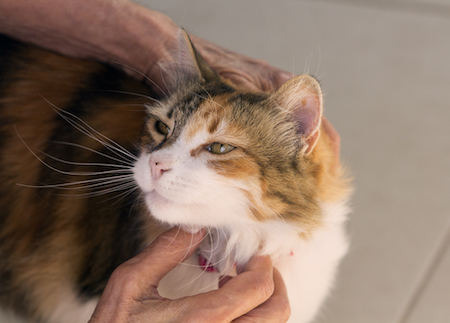
Can you prevent cat acne?
There are many ways to help prevent your cat from developing chin acne. Speak with your cat’s vet before starting any at-home care regimens because some human products can be toxic for cats. In the meantime, here are steps to limit your cat’s chances of developing acne.
- minimize your cat’s stress levels
- switch plastic bowls to steel, ceramic, or porcelain
- check for allergies and parasites
- improve your cat’s hygiene
Although you may not be able to prevent your cat from ever developing acne entirely, these steps can go a long way toward keeping your cat acne-free.
Keep your cat healthy with a pet insurance plan.
Cats need pet insurance just as much as dogs! Protect your feline friend with an affordable pet insurance plan from top insurance providers. Fill out a free quote for your cat, and let Pet Insurance Review find the best policy matches for your pet’s needs and your budget.
References:
- Fitzsimmons, P. (2021). Cat Chin Acne: Why It Happens and How to Help. Retrieved from https://www.greatpetcare.com/cat-health/cat-chin-acne-why-it-happens-and-how-to-help/
- Scott, D., Miller, W. (2010). Feline Acne: A Retrospective Study of 74 Cases (1988 – 2003). Retrieved from https://www.jstage.jst.go.jp/article/jjvd/16/4/16_4_203/_article
- Wilson, J. (n.d.). Folliculitis in Cats. Retrieved from https://cat-world.com/folliculitis-in-cats/
- Donner, S. (2013). Do Plastic Water Bowls Cause Feline Acne? Retrieved from https://www.catster.com/lifestyle/261cat-lady-sarah-donner-plastic-water-bowls-feline-acne
- Messonnier, S. (2014). Essential fatty acids for felines. Retrieved from https://animalwellnessmagazine.com/essential-fatty-acids-for-felines/
- Jazic, E. (2013). Chin Dermatitis in a Cat. Retrieved from https://files.brief.vet/migration/article/8656/chin-dermatitis-in-a-cat-8656-article.pdf
- Falconer, J. (2021). Reducing stress for cats. Retrieved from https://www.humanesociety.org/news/keeping-cats-stress-free
The information contained on this blog is intended for informational and educational purposes only and should not be construed as medical advice. It is not a substitute for professional veterinary care. Always consult with your veterinarian before making any changes to your pet's health care or treatment plan.
The authors of this blog are not veterinarians and do not claim to be experts in pet health. The information provided here is based on our own experiences and research, as well as information from reputable sources. However, we cannot guarantee the accuracy or completeness of this information.
We encourage you to do your own research and consult with your veterinarian before making any decisions about your pet's health.
Previous post
6 Tips to Keep Your Dog Cool this SummerCompare top pet insurance providers & plans.
Enter your dog’s age in years and months to calculate their age equivalent to human years.
Calculate your dog’s ageEnter your cat’s age in years and months to calculate their age equivalent to human years.
Calculate your cat’s age